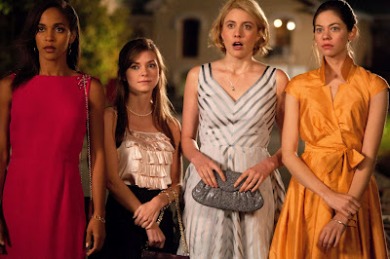
Puss In Boots, easily one of the best parts of the film.
I have been babysitting, so the last few films I’ve seen have been aimed at a younger crowd. I had seen Shrek 2 before – in cinemas, even – but the second time around didn’t do it many favours, emphasising what I disliked and taking away from the fun parts. And, yes, there are quite a few fun parts, between the songs, the clever animation and new characters like Puss In Boots and the Fairy Godmother. But oh, some of the film annoys the crap out of me. And not in a ‘aimed for children’ kind of way, either.
The plot is basic – Shrek (Mike Myers) and Fiona (Cameron Diaz) get some happily every after time before they’re invited to the land of Far Far Away to be officially recognised by Fiona’s parents (John Cleese and Julie Andrews). Donkey (Eddie Murphy) comes along, poor relations ensue, the Fairy Godmother (Jennifer Saunders) and Puss In Boots (Antonio Banderas) get involved, and everything, once more, works out for the best. Which is all well and good and fine. The voicework ranges from workaday (Diaz) to effective (Rupert Everett as Prince Charming, most everyone else) to downright terrific (Saunders and Banderas). The concept of Far Far Away as Hollywood riffs on the joke of Lord Farquaad from the first movie being a parody of Michael Eisner, former head of Disney, and provides for a few amusing – albeit, adult-aimed – references. Even a few of the more popular side characters from the first film pop up, most notably Pinocchio and the Gingerbread Man.
But though it’s bright and peppy, it’s also not good. Primarily because Shrek and Fiona are easily the most boring part of their own film. Worse, while Fiona’s just rather dull, Shrek is actively kind of a dick, arguing, grumbling and attempting to stubborn his way through things. Compared to them, the schemes of the Fairy Godmother and the hastily-dropped plot of Puss In Boots as an assassin are so much more fun, that I spent the film wanting the villains to win, not the ostensible heroes. While Shrek and Fiona are having contentless arguments and boring, boring spats, everyone else, especially those working against them, holds the audience’s attention much better. Though while the antagonists get the humour and the audience’s engagement, they also get the bulk of the cheap pop culture references that make up the bulk of what passes for enjoyable in your lesser children’s movies. At least Shrek and Fiona keep ahold of most of the tired montages set to a pop song, preferably a cover by a very of-the-moment artist of a stone cold classic. None of this is new to Shrek 2 – they’re just quite egregious in this installment.
Also, there are many plot elements that bothered me. I won’t go into the ending’s problems, except to say it implies that Fiona is required to make more sacrifices than Shrek, which is rather problematic. But there are other problems. While arguing over their first dinner together, Shrek takes offense when the King suggests that he might eat his young, a case of ogre stereotyping… except that in one of the other Shrek films it’s said that father ogres do often try to eat their children, and it happened to Shrek too, with his own dad. So Shrek might want to be less huffy at the outlandish accusation and more acknowledging of a very real thing that ogres do, and that a new father-in-law might be worried about.
Or, and this one really annoys me for reasons I can’t even fully explicate – a group of the creatures from the first film, including the Three Blind Mice, Three Little Pigs and Pinocchio, all come to Shrek’s rescue after seeing him arrested on television. Yes, the fantasy kingdom, and the isolated swamp Shrek lives in, have TV. Anyway, despite the journey taking a montage-y long time when Shrek, Fiona and Donkey took it, the other characters manage to get to Far Far Away that day, and try to break Shrek and Donkey out of prison. The final thing needed to do so is to get Pinocchio to grow his nose, so the other characters tell him to lie. Any lie will do. The suggestion is made for him to say he’s wearing women’s underwear, which he does… but his nose doesn’t grow, because it turns out he is. A pink thong, even. His embarrassment about it and follow-up lies get his nose to grow, and the rescue succeeds.
Now. Why on earth would he say it in the first place? Knowing that he’s wearing women’s underwear, he surely wouldn’t say that he wasn’t wearing it, because it would show he was. And, weird enough that they want to make a joke about a boy wearing grown-up women’s underwear, but if they are so wedded to the joke, the writers could easily have had him balk at saying it in the first place, and then have the scene proceed as before. But no, Pinocchio says something he knows is true when asked to tell a lie, and it just goes so against how people, wooden or otherwise, behave, that this relatively miniscule moment aggravates me out of the movie. It a little vortex of wrongness, in character, concept and motivation, and it’s just stupid enough to make me like the whole film less.
Unfortunately, it has help from the film’s other weaknesses. I remember Shrek as being better and Shrek 3 as worse, and have not seen the fourth, but I don’t plan on rewatching them any time soon. Of course, babysitting being what it is, that’s no guarantee.









